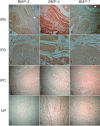Expression of bone morphogenic protein in sinonasal inverted papilloma with new bone formation
- PMID: 22852110
- PMCID: PMC3390124
- DOI: 10.2500/ar.2011.2.0004
Expression of bone morphogenic protein in sinonasal inverted papilloma with new bone formation
Abstract
Inverted papilloma (IP) is a common benign tumor in the nose and sinus. Osteogenesis in sinonasal IP is extremely rare; to date, only five cases of IP with new bone formation appear in the literature. In addition, the mechanism of osteogenesis in IP remains unclear. Here, we describe three cases of IP with new bone formation and an investigation into a possible role for bone morphogenic protein (BMP) in osteogenesis. Of three patients with sinonasal IP with new bone formation, two were treated by endoscopic sinus surgery and one was followed up with watchful waiting. Tumor tissues were subjected to immunohistochemistry to detect BMP expression. The patients were successfully treated surgically and showed no evidence of recurrence postoperatively. Follow-up examination is ongoing. Immunohistochemically, the tumors expressed BMP-4 but not BMP-2 or BMP-7. ESS could be successfully used to achieve complete removal of the sinonasal IPs with new bone formation. BMP-4 might be associated with new bone formation in the tumor.
Keywords: Bone formation; bone morphogenic protein; endoscopic sinus surgery; inverted papilloma; sinonasal.
Conflict of interest statement
The authors have no conflicts to declare pertaining to this article
Figures





Similar articles
-
Sinonasal schwannoma with new bone formation expressing bone morphogenic protein.Int J Otolaryngol. 2010;2010:154948. doi: 10.1155/2010/154948. Epub 2010 Dec 19. Int J Otolaryngol. 2010. PMID: 21197441 Free PMC article.
-
Clinical features of nasal and sinonasal inverted papilloma associated with malignancy.Auris Nasus Larynx. 2018 Oct;45(5):1014-1019. doi: 10.1016/j.anl.2018.02.009. Epub 2018 Mar 13. Auris Nasus Larynx. 2018. PMID: 29548524
-
DIAGNOSIS AND TREATMENT OF PATIENTS WITH SINONASAL INVERTED PAPILLOMA.Georgian Med News. 2020 Sep;(306):31-37. Georgian Med News. 2020. PMID: 33130642
-
Sinonasal inverted papilloma associated with small cell neuroendocrine carcinoma: A case report and literature review of rare malignancies associated with inverted papilloma.Auris Nasus Larynx. 2019 Aug;46(4):641-650. doi: 10.1016/j.anl.2018.10.009. Epub 2018 Dec 10. Auris Nasus Larynx. 2019. PMID: 30545727 Review.
-
Sinonasal inverted papilloma: From diagnosis to treatment.Eur Ann Otorhinolaryngol Head Neck Dis. 2016 Nov;133(5):337-341. doi: 10.1016/j.anorl.2016.03.006. Epub 2016 Apr 1. Eur Ann Otorhinolaryngol Head Neck Dis. 2016. PMID: 27053431 Review.
Cited by
-
Advances in recurrence and malignant transformation of sinonasal inverted papillomas.Oncol Lett. 2017 Jun;13(6):4585-4592. doi: 10.3892/ol.2017.6089. Epub 2017 Apr 24. Oncol Lett. 2017. PMID: 28599459 Free PMC article.
-
Schneiderian papillomas: comparative review of exophytic, oncocytic, and inverted types.Am J Rhinol Allergy. 2013 Jul-Aug;27(4):287-92. doi: 10.2500/ajra.2013.27.3904. Am J Rhinol Allergy. 2013. PMID: 23883810 Free PMC article.
-
[Ossification of nasal septal polyps: a case report].Lin Chuang Er Bi Yan Hou Tou Jing Wai Ke Za Zhi. 2022 Sep;36(9):719-720. doi: 10.13201/j.issn.2096-7993.2022.09.014. Lin Chuang Er Bi Yan Hou Tou Jing Wai Ke Za Zhi. 2022. PMID: 36036076 Free PMC article. Chinese.
-
Value of a Multidisciplinary Approach in Sinonasal Inverted Papilloma with Extensive Ossification.Am J Case Rep. 2022 Feb 4;23:e934149. doi: 10.12659/AJCR.934149. Am J Case Rep. 2022. PMID: 35115482 Free PMC article.
References
-
- Chiu AG, Jackman AH, Antunes MB, et al. Radiographicand histologic analysis of the bone underlying inverted papilloma. Laryngoscope 116:1617–1620, 2006 - PubMed
-
- Dadas B, Ercan I, Basak T. Inverted papilloma with new bone formation in ethmoidofrontal region. Otolaryngol Head Neck Surg 134:343–344, 2006 - PubMed
-
- Unlu HH, Songu M, Ovali GY, Nese N. Inverted papilloma with new bone formation: Report of three cases. Am J Rhinol 21:607–610, 2007 - PubMed
-
- Tsuzuki K, Nishigami T, Takebayashi H, et al. Inverted papilloma with osteogenesis in the anterior ethmoid and frontal sinuses. J Laryngol Otol 124:230–233, 2010 - PubMed
LinkOut - more resources
Full Text Sources

